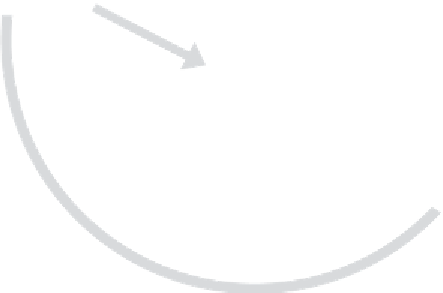Environmental Engineering Reference
In-Depth Information
FIGURE 7.4
The Hydrologic Cycle and Typical
Residence Time of Water in Natural
Reservoirs
ATMOSPHERE
8 days
Water moves from one reservoir to
another by way of natural processes
like evaporation, condensation, precipi-
tation, runoff, infi ltration, transpiration,
melting, and groundwater fl ow.
PRECIPITATION
Glacier,
Snow
2%,
20-100 years
EVAPORATION
RUNOFF/RIVERS
SURFACE WATER
Ocean
97%,
>1,000 years
Lakes
GROUND
Soil Moisture,
Groundwater
100 - 10,000 years
(shallow - deep)
GROUNDWATER FLOW
precipitation, runoff, infiltration, transpiration, melting, and groundwater flow. In areas
where water is scarce or human population is high, human activities can change the local
natural hydrologic cycle. It is now also widely accepted that industrialization including
mining has contributed to global warming, which is associated with notable shifts in the
global hydrologic cycle.
Water is continually cycled between the various storage media. The time of residence
in any particular medium is an important factor in any assessment of water pollution
(
Figure 7.4
). On average water is renewed in rivers once every 16 days. Water in the atmos-
phere is completely replaced every eight days. Slower rates of replacement occur in large
lakes, glaciers, ocean bodies, and groundwater. Replacement in these reservoirs can take
from hundreds to thousands of years. Some of these resources (especially groundwater) are
being used by humans at rates that far exceed their renewal times and water becomes effec-
tively nonrenewable. Some groundwater, referred to as 'fossil water' is water which was
stored in the distant past and is no longer subject to renewal.
Water as a Scarce Resource
Water is essential to life. It is also the most widely occurring substance on Earth; how-
ever, fresh water represents less than 3 percent, the remainder being salt water, as illus-
trated in
Figure 7.4
. Some two-thirds of freshwater is locked up in glaciers and permanent
snow cover. Availability of the remaining one-third differs widely in different parts of
the world, with wide variation in seasonal and annual precipitation. Industrial, human,
and agricultural wastes are discharged to receiving waters, further polluting much of the
fresh water that exists. At the same time, the human population is growing, as is per capita
water use. The consequence is that unpolluted fresh water is becoming increasingly scarce.



















Search WWH ::

Custom Search